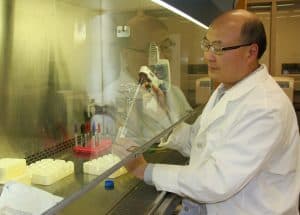Research Opens New Possibilities for Treatment for Osteoporosis and Other Bone Diseases
| Jan. 5, 2017 | A team of University of Arkansas for Medical Sciences (UAMS) researchers have made key advances in the understanding of how bone is maintained, opening new avenues for the development of treatments for osteoporosis, arthritis and bone metastasis of certain types of cancer.
Haibo Zhao, M.D., Ph.D., associate professor of medicine and physiology in the Department of Endocrinology and the Department of Physiology and Biophysics in the UAMS College of Medicine – published his findings recently in JCI Insight, a leading peer-reviewed journal in biomedical research.
Zhao’s work improved scientists’ understanding of osteoclasts – bone cells that remove old or damaged bone. Other cells – called osteoblasts – come behind osteoclasts and form new bone. Both cells must be functioning properly for bones to grow and stay strong.
For example, in osteoporosis, osteoclast activity outpaces that of osteoblasts, meaning a greater amount of bone is removed than is replaced. This causes bones to weaken and become more susceptible to fractures.
Scientists have previously outlined this relationship between the cells that remove old bone and cells that form new bone, but Zhao’s work focused on what causes osteoclasts to malfunction, which is less understood.
Zhao targeted a specific type of protein – PLEKHM1 – and demonstrated that its absence decreased the function of the osteoclasts. Further investigation found that the protein is a critical factor in some of the intracellular functions – specifically involving lysosomes – that are essential for osteoclasts to operate.
“The major finding of this work is how this protein works,” Zhao said. “PLEKHM1 and its interacting molecules could represent very useful drug development targets for the treatment of osteoporosis and other bone diseases.”
After determining its function, the next step will be to better understand PLEKHM1’s structure so that it can be targeted by drugs that could treat osteoporosis and other bone conditions in which osteoclasts malfunction. Zhao has already secured National Institutes of Health funding to pursue this next step, along with Kottayil I. Varughese, Ph.D., professor in the Department of Physiology and Biophysics, who is co-principal investigator on the project.
“Dr. Zhao is a very talented and internationally recognized researcher in the basic biology of osteoclasts,” said Stavros C. Manolagas, M.D., Ph.D., director of the UAMS Center for Osteoporosis and Metabolic Bone Diseases, which partially funded Zhao’s research.
“An inappropriate decrease or increase in the number or activity of these cells causes many diseases, including osteoporosis, or the destruction of bone in multiple myeloma and other cancers,” said Manolagas. “Dr. Zhao’s latest work provides new fundamental insights of how osteoclasts resolve bone by secreting acids and other chemicals. The discoveries reported in the prestigious Journal of Clinical Investigation Insights open new avenues for the development of drugs that can treat these diseases.”
The article, titled “PLEKHM1/DEF8/RAB7 complex regulates lysosome positioning and bone homeostasis,” was published Oct. 20. UAMS faculty who assisted with the work were Manolagas; Varughese; and Daniel E. Voth, Ph.D., of the Department of Microbiology and Immunology, and Samuel G. Mackintosh, Ph.D., of the Department of Biochemistry and Molecular Biology, both in the College of Medicine. Postdoctoral fellows Toshifumi Fujiwara, M.D., Ph.D.; and Shiqiao Ye, Ph.D., assisted with the work, as did graduate student Caylin G. Winchell, Ph.D.
The work was funded by a grant from the NIH/National Institute on Aging to Manolagas and the Center for Osteoporosis and Metabolic Bone Diseases of more than $1 million a year for five years; and a grant from the NIH/National Institute of Arthritis and Musculoskeletal and Skin Diseases to Zhao of $220,500 a year for five years. The project’s next phase will be funded by a grant from the NIH/NIAMS to Zhao and Varughese of $135,000 a year for two years.
Zhao received his Ph.D. and M.D. from Tongji Medical University in Wuhan, China. He has been at UAMS since 2009. Previously he held a faculty position in the Department of Pathology and Immunology at the Washington University School of Medicine in St. Louis. His work on improving the scientific understanding of osteoclasts has spanned more than 20 years.
The Center for Osteoporosis and Metabolic Bone Diseases, founded by Manolagas at UAMS in 1994, is one of the largest and longest-funded osteoporosis research centers in the world. The center has brought $83 million in grants to UAMS. Its researches have made seminal discoveries in pursuit of more effective therapies for the more than 10 million Americans who suffer from bone-fracturing osteoporosis and 34 million individuals with low bone mass.
UAMS is the state’s only health sciences university, with colleges of Medicine, Nursing, Pharmacy, Health Professions and Public Health; a graduate school; a hospital; a main campus in Little Rock; a Northwest Arkansas regional campus in Fayetteville; a statewide network of regional campuses; and eight institutes: the Winthrop P. Rockefeller Cancer Institute, Jackson T. Stephens Spine & Neurosciences Institute, Harvey & Bernice Jones Eye Institute, Psychiatric Research Institute, Donald W. Reynolds Institute on Aging, Translational Research Institute, Institute for Digital Health & Innovation and the Institute for Community Health Innovation. UAMS includes UAMS Health, a statewide health system that encompasses all of UAMS’ clinical enterprise. UAMS is the only adult Level 1 trauma center in the state. UAMS has 3,485 students, 915 medical residents and fellows, and seven dental residents. It is the state’s largest public employer with more than 11,000 employees, including 1,200 physicians who provide care to patients at UAMS, its regional campuses, Arkansas Children’s, the VA Medical Center and Baptist Health. Visit www.uams.edu or uamshealth.com. Find us on Facebook, X (formerly Twitter), YouTube or Instagram.###

